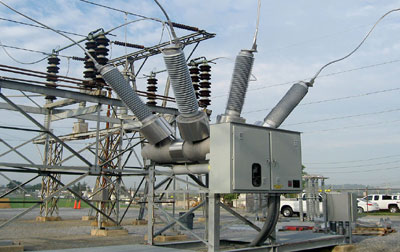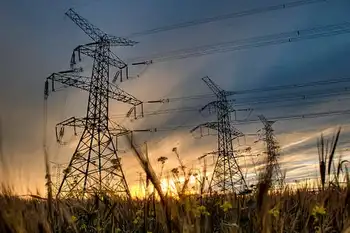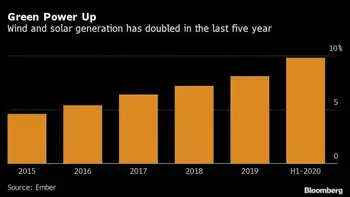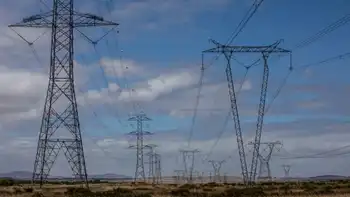The brains of BC Transmission
By Vancouver Sun
Electrical Testing & Commissioning of Power Systems
Our customized live online or in‑person group training can be delivered to your staff at your location.

- Live Online
- 12 hours Instructor-led
- Group Training Available
The room feels cool and dry, and it's quiet here.
This is the guts of the new grid control centre that BC Transmission Corp. is entrusting to ensure smooth and steady delivery of power in the coming decades to 1.7 million BC Hydro customers, their hospitals, schools, businesses, industries, streetlights, and homes.
A man steps up to one of the racks, places his hands on it, and gives it a really rough, vigorous shake.
The rack rocks back and forth but its movement is controlled as it would be in an earthquake, because it rests on a ball-bearing-loaded floor plate that safely disperses the energy released in a quake.
The fluorescent lights in the ceiling stay on.
"That system is live right now," says Bruce Barrett, BCTC vice-president for major projects, during a tour of the facility with a Vancouver Sun reporter and photographer. "We expect that if an earthquake happens, it will not take the computer down."
It was built to a one-in-10,000-year earthquake standard, adds Martin Huang, BCTC vice-president for systems operation. "So if anything in the Lower Mainland should disappear, this facility should still be standing."
The Sun was free to tour and take photographs inside the facility, but requested not to disclose its precise location.
As the tour progressed, it became clear that BCTC has established about a dozen layers of backup support in the event of a disaster that might knock out conventional power supply.
There are 50 computer racks. Each runs blackout simulation every two minutes. And if it sniffs out a problem, it moves to fix it.
If a computer crashes, another takes over, then another, and so on.
Digital microwave and fibre-optic communications systems keep it connected at all times to 260 substations across B.C.
In the event of a sudden power failure, a 480-volt battery the size of a typical living room takes over to keep the system alive without interruption.
If it should fail, there's even a second battery.
Next, there's a diesel generator, and a backup diesel in another part of the facility - and a week's worth of fuel in case there's a delay in restoring outside power.
That's just half the story.
"We do have another facility almost like this one in the Okanagan. If something (catastrophic) happened in the Lower Mainland, we could operate the grid from the Okanagan with a very minimal staff," says Huang, the on-site boss of this 150-person operation.
Like the Fraser Valley facility, the one in the Okanagan has two giant batteries and two diesel generators as backup.
Taxpayers take note. This control centre, and the one in the Okanagan, were built on time and on budget for a total of $130 million.
But it's not just a matter of security.
B.C. is entering a new era in which small sources of green energy like wind power and run-of-river hydro will be joining the grid. They will provide intermittent, not steady, power, and it takes a computer to ensure the flow of electricity across the grid remains stable.
B.C. is also a big energy trader, and power utility regulators in the United States demand a high standard of reliability that the new facility is exceptionally well-equipped to provide.
There's a side benefit - the system developed by BCTC is so sophisticated that the Crown corporation will be able to market the technology to other utilities.
The system should also help contain electricity rate hikes, Huang says. There's less risk of a blackout, and less need to spend money buffering the system with extra wires and transformers because the new technology allows BCTC to operate closer to the limits of the grid "without violating any reliability and safety requirements."
Upstairs from the racks is a room about the size of a movie theatre, filled with metre-wide computer monitors that fan around individual workstations.
This is where the human element of the system emerges.
The provincial electricity grid is comprised of 260 substations, 18,000 kilometres of transmission lines, and 95,000 towers and poles, operating at voltages from 69 to 500 kilovolts, and stretching over 75,000 hectares of ground.
Ultimately, it's up to the people who sit at these monitors to decide the best move for keeping the system running in the event of a small event - like a tree falling onto a line - or a big one, like a blown transformer or a civil emergency.
At the time of The Sun's visit, BCTC special projects manager Bob LaBelle was in the process of training the operators who will run the system.
You can start with a diagram of the entire B.C. mainline transmission grid, and delve down into it until you've got a display of the distribution system in a single neighbourhood anywhere in the province.
If there's a wonky transformer somewhere, you can re-route electricity around it in moments with a few clicks of a mouse.
You can also perform recognizance, or examine the efficiency, performance, ranking and functionality of a single generator in a hydroelectric station anywhere in B.C.
Or you can back out of the local system, layer upon layer, until you've got a macro-level diagram of the western North America grid, from northern B.C. and Alberta all the way to the Mexican border.
It's critical work.
All it took was a tree falling on a powerline in August 2003, and a failure by grid operators in Ohio to react quickly, to touch off an escalating blackout that affected 50 million people in Ontario and the U.S. northeast, and caused $6 billion in economic losses.
LaBelle started out with BC Hydro in 1967, Canada's centennial year. He got his hands dirty cleaning and refurbishing transformers, generators and other gear that stabilize electricity flow.
The people keeping vigil over the grid worked in substations, and spoke via telephone when a part of the system went down.
Today, the only terminal a young operator is familiar with is a flat-screen display linked to a mainframe.
As a result, LaBelle will be spending a lot of time training operators and running them through simulations so that they're well-prepared to act quickly in the event of any disruptions on the grid.
"In my days, you'd say, 'Aw, I can handle this,' and you just took the line out. It was a macho kind of a thing," LaBelle recalls.
"We don't have people who learn the system from the ground up any more. They come out of universities, or BCIT, and some of them, when we hire them, have never seen a generator, never mind [having] gone down and [worked with] the brush gear.
"So simulation now becomes really critical to what we do. We take people and put them into situations where we give them the worst scenario possible, and show them how to build the system back in again.
"Then, when it happens for real they've already seen it for the first time - that pounding in your heart, and trying to keep yourself under control while the world is coming apart."















